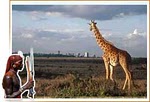Saturday, October 4, 2008
Kenya: Big Cats Roaring Back Into Nairobi Park Ecosystem................
The Kenya Wildlife Service and Friends of the Nairobi National Park (FoNNaP) staged a ceremony on August 21 at the main gate to the Nairobi National Park to celebrate the return of lions and other big cats to the Nairobi National Park.
The resurgence in the big cat population is the result of a successful Consolation Scheme now administered by FoNNaP and the Lease Programme funded and implimented by The Wildlife Foundation.
Conservationists and fans of the Nairobi National Park were jolted into action in 2003, when 11 lions were killed near the park. According to Inge Burchard, the chief scientist from FoNNaP for the park and the Kitengela ecosystem, this was because the pastoralists whose livestock had been killed by lions were not compensated when the Lion Endowment Fund ran out. Acting on her appeal, Alan Donovan, a co-founder of African Heritage offered to organise the First African Heritage Day at his house overlooking the park, to raise funds for the Call of the Lions. In 2004, 600 people arrived at his house on the original Kenya-Uganda steam train, with US ambassador Mark Bellamy and Carmelo Cocuzza of the European Investment Bank as special guests of honour. Since that time, there have been two more successful fundraisers held at the African Heritage House for the benefit of the lions and other big cats who inhabit the park.
Last year, Rift Valley Railways provided one of its new diesel engines with newly painted passenger cars for the several hundred guests who made the trip to the Athi Plains.
German ambassador Walter Lindner assisted in providing entertainment (by Eric Wainana and Ayub Ogada) for the occasion, and US ambassador Michael Ranneberger was the guest of honour. He expressed his government's support for the park and other projects in the wildlife sector amounting to $10.4 million between 2006 and 2010.
The Kenya Wildlife Service received $2.5 million last year to implement, over the next four years, management actions in support of its 10-year strategic plan. Some of these funds are invested directly in Nairobi Park.
It is one of the first parks in the KWS system to benefit from the SmartCard system.
KWS is also implementing the Nairobi National Park ecosystem management plan, which includes linkages with new US support for the Kitengela wildlife dispersal area, including another grant of $1.6 million this year provided by USAID.
If the park is to retain its unique character and biodiversity, it is essential that migratory routes continue to run through it.
FoNNaP has set a goal of Ksh50 million ($714,000) for a new Lion Endowment Fund to make it self-sustaining -- it will utilise only the interest on the fund to make compensation payments. However, it will take much more than that to restore the wildlife corridors.
There are many potential donors willing and able to assist as is exemplified by the wide support for the Call of the Lions.
Proceeds from the African Heritage Days also go to the Lion Endowment Fund.
US ambassador Mr Ranneberger says the Call of the Lions is a model programme as it involves both public and private sources as well as individuals who may offer their support while they pay homage to the rich environmental, wildlife and cultural heritage of the African continent. At the last African Heritage Day, Mr Ranneberger underscored the continuing US commitment to help preserve Kenya's rich wildlife heritage and, in particular, the Nairobi National Park. He urged everyone to enthusiastically support this effort, adding, "I am sure that, one of these days, we will hear the lions roar their approval."
The next African Heritage Day, said Mr Donovanwill combine the public opening ceremony of the Murumbi Peace Memorial at Nairobi's City Park with the opening of a new gate to Nairobi National Park by the Kenya Wildlife Service on Mombasa Road.
Subscribe to:
Posts (Atom)

